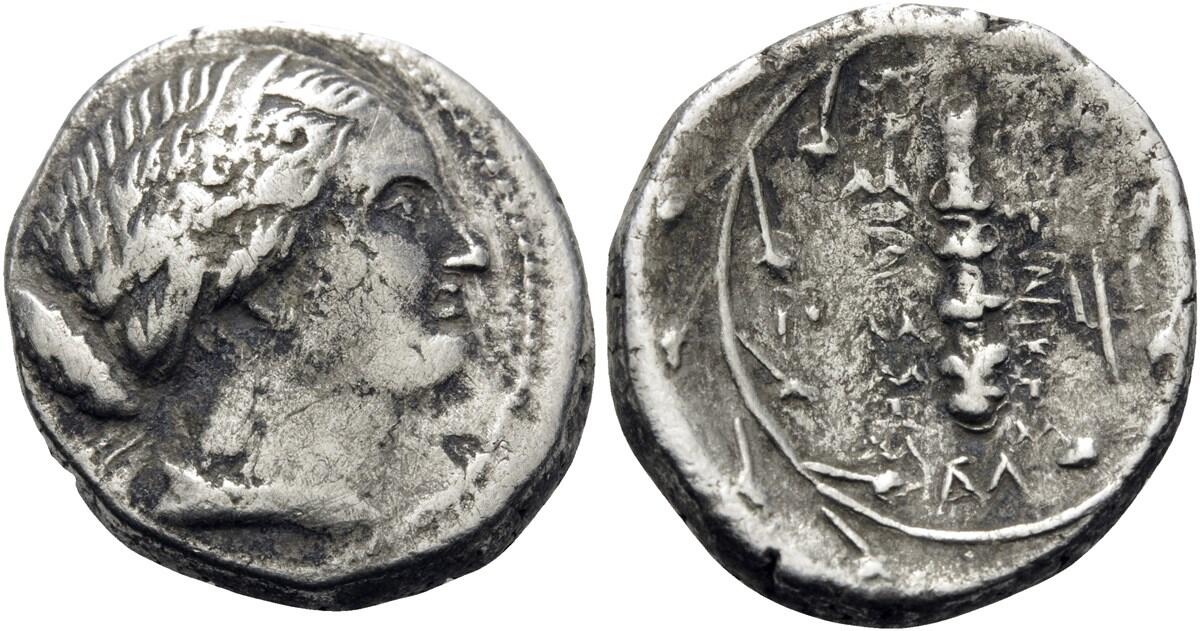Euhesperides (Ptolemy III), silver, didrachms (246-222 BCE)
From SILVER
246 BCE - 222 BCE Silver 2,430 kg
Description
| ObverseInscription or printing placed on the obverse.: | Diademed and draped bust of Berenike to right |
| ReverseInscription or printing placed on the reverse.: | BAΣIΛIΣΣHΣ BEPENIKHΣ (Greek).Club above monogram, to right, trident, to left, Π, all within laurel wreath |
Mint and issuing power
| MintIdentifies the place of manufacture or issue of a numismatic object.: | Euhesperides | Ancient regionAncient region.: | Cyrenaica | Modern countryModern country: Libya | AuthorityIdentifies the issuing power. The authority can be "pretended" when the name or the portrait of X is on the coin but he/she was not the issuing power. It can also be "uncertain" when there is no mention of X on the coin but he/she was the issuing power according to the historical sources: | Berenice II Euergetis (Ptolemaic queen and co-regent, 267/266-221 BC), Ptolemaic dynasty (323-30 BC), Ptolemy III Euergetes (Ptolemaic king, 246-222 BC) |
Chronology
| FromIdentifies the initial date in a range assigned in a numismatic context. | 246 BCE | toIdentifies the final date in a range assigned in a numismatic context.. | 222 BCE | PeriodTime period of the numismatic object.: Hellenistic 323-30 BC |
Physical description
| MetalThe physical material (usually metal) from which an object is made.: | Silver |
Median weightMedian of the weights of numismatic objects (in grams). in grams | 6.90 | DenominationTerm indicating the value of a numismatic object. Examples: tetradrachm, chalkous, denarius.: | didrachm |
StandardStandard.: | Ptolemaic |
Image

10054121.jpg [1]
References
| Die study referencePublication of the study: | Asolati - Crisafulli 20181Asolati - Crisafulli 2018, p. 25 | ||
| Coin series referenceReference to coin series study: | Svoronos 1904-19082Svoronos 1904-1908, no. 320, CPE I3CPE I, 729 | ||
| Coin series web referenceCoin series web references: | |||
Obverse dies distribution
| FrequencyFrequency of specimen in distribution. ᵖ | Number of obversesNumber of obverse dies. ᵖ (o) | % (o) | Number of coinsNumber of coins. (n) | % (n) | Die nameName(s) of the die(s). |
| 1 | 6 | 37.5 | 6 | 7.14 | L, M, N, O, Q, R |
| 2 | 4 | 25 | 8 | 9.52 | D, E, I, P |
| 3 | 1 | 6.25 | 3 | 3.57 | F |
| 8 | 1 | 6.25 | 8 | 9.52 | H |
| 9 | 1 | 6.25 | 9 | 10.71 | B |
| 11 | 1 | 6.25 | 11 | 13.1 | G |
| 13 | 1 | 6.25 | 13 | 15.48 | A |
| 26 | 1 | 6.25 | 26 | 30.95 | C |
| Total | 16 of 16 | 100 | 84 of 84 | 99.99 |
Reverse dies distribution
no distribution is available
Quantification
| Number of obversesNumber of obverse dies. ᵖ (o) | 16 | Number of singletons (o1)The number of singleton coins. ᵖ | 6 |
| Number of reverse diesNumber of reverse dies. (r) | 37 | Number of coinsNumber of coins. (n) | 84 |
| Coins per obverse dieNumber of coins per obverse die. (n/o) | 5.25 | Coins per reverse dieNumber of coins per reverse die. (n/r) | 2.27 |
| Reverse per obverse ratioRatio of obverse dies divided by reverse dies. (r/o) | 2.31 | Percentage of singletons (o1)number of coins (n) divided by the number of singletons (o1) ᵖ | 37.5 % |
| Original number of dies (O) (Carter 1983 formula)The estimation of the number of coins according to Carter 1983 ᵖ | 17.61 | Coins struck if 20,000 as average productivity per dieCoins made if the average productivity for obverses (according to Carter) is 20,000. ᵖ | 352,200 |
| Original number of dies (O) (Esty 2011 formula)The estimation of the number of coins according to the singleton formula in Esty 2011 ᵖ (O) | 19.76 | Survival rate if 20,000 as average productivity per dieSurvival rate if average productivity is 20,000. ᵖ | 0.00024 |
| Coverage (o = % of O) (Esty 1984 formula)Esty 1984 - coverage (% of O) ᵖ (o = % of O) | 92.86% | Die productivity if survival rate 1/2,000Average productivity if survival rate is 1/2,000. ᵖ | 9,540.03 |
| Weight of silver (in kg) if 20,000 coins per die (O = Carter formula)Carter 1983 * Median weight * 20000 (*10 if gold or electrum) ᵖ | 2,430 kg <br /> 2,430 kg | Die productivity if survival rate 1/5,000Average productivity if survival rate is 1/5,000. ᵖ | 23,850.09 |
Remarks
Most likely one single workstation